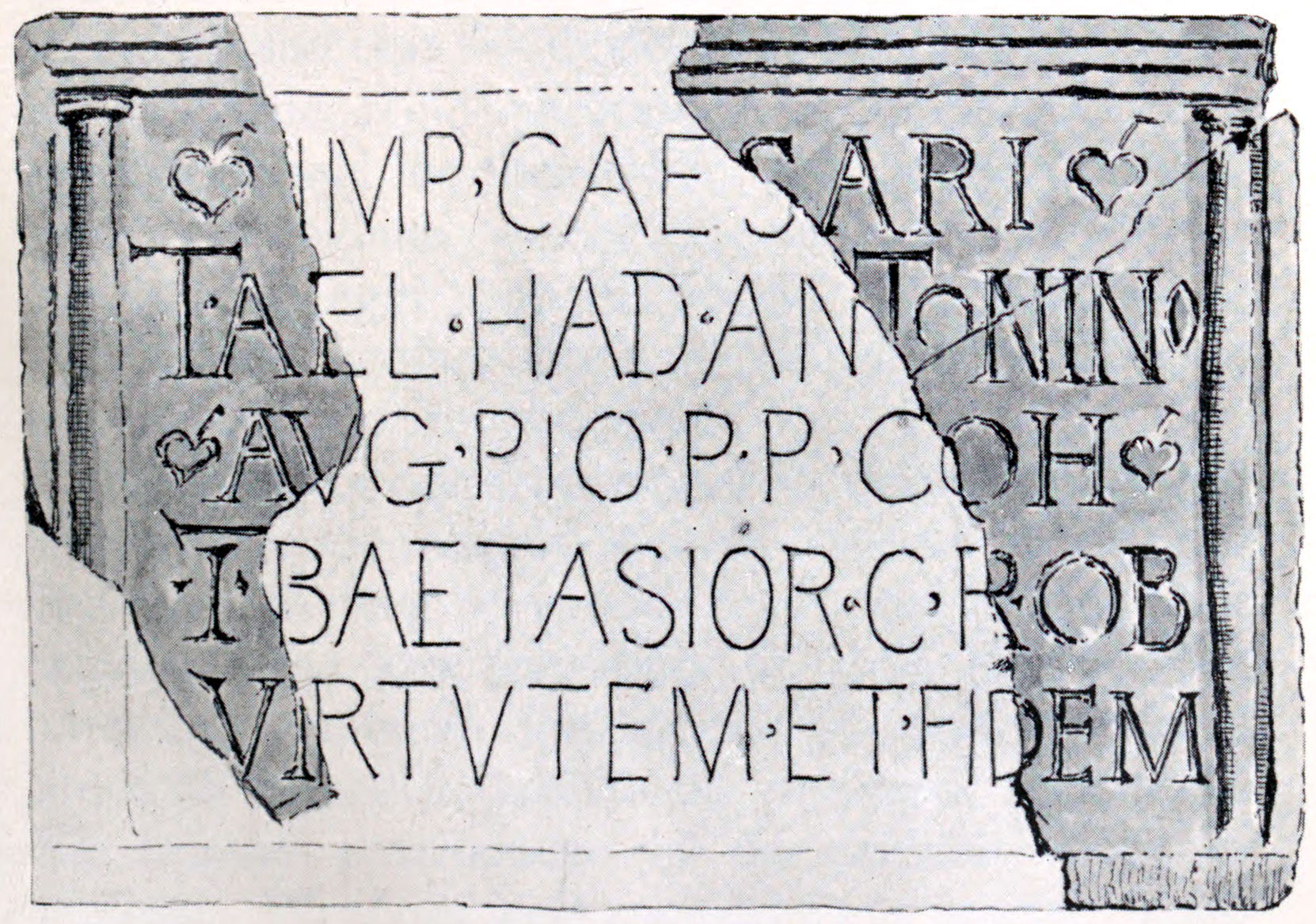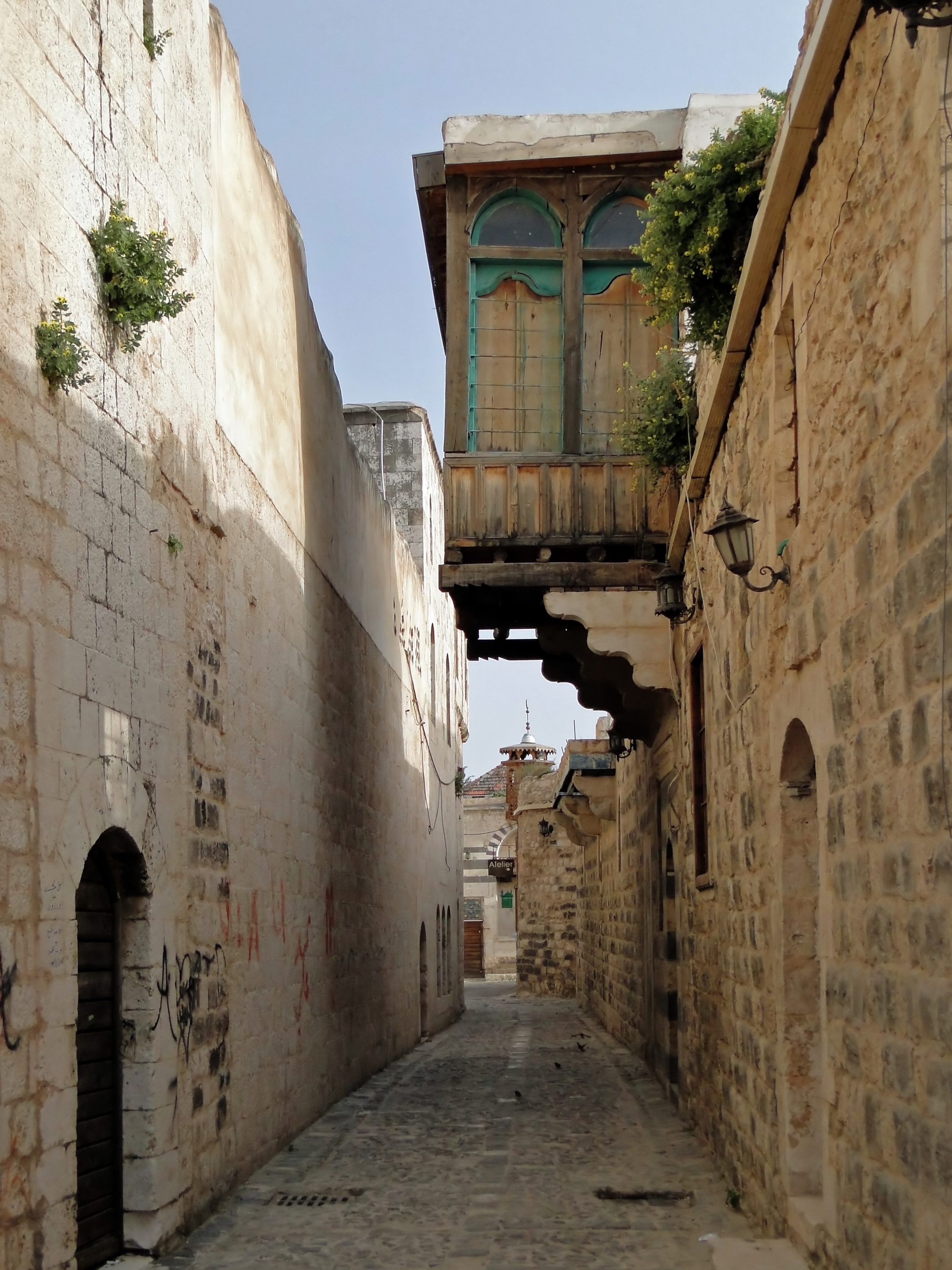|
Cohors I Hamiorum
Cohors I Hamiorum sagittariorum ("1st Cohort of Hamian Archers") was a Roman auxiliary infantry unit of archers raised near the ancient city of Hama, Syria. It was a cohors quingenaria consisting of 480 men. The unit's origins are unknown and it is unclear when the unit was first created; however, its existence can be definitively attested in the reign of Hadrian. Military diplomas from the years 122 (CIL 16.69), 124 (CIL 16.70), 127 (RMD 240), and 135 AD (CIL 16.82) show that the unit was stationed in Britannia at Magnis (Carvoran). It is the only regiment of archers known to be stationed in Britain. The unit was transferred to Caledonia sometime during the reign of Antoninus Pius according to three inscriptions found at the Bar Hill Fort on the Antonine Wall. In 163 or 164 AD, the regiment was transferred back to Carvoran. The regiment's whereabouts prior to its deployment in Britain are not known, but some scholars, such as Paul Holder, have posited that the regiment first ... [...More Info...] [...Related Items...] OR: [Wikipedia] [Google] [Baidu] |
Roman Empire
The Roman Empire ruled the Mediterranean and much of Europe, Western Asia and North Africa. The Roman people, Romans conquered most of this during the Roman Republic, Republic, and it was ruled by emperors following Octavian's assumption of effective sole rule in 27 BC. The Western Roman Empire, western empire collapsed in 476 AD, but the Byzantine Empire, eastern empire lasted until the fall of Constantinople in 1453. By 100 BC, the city of Rome had expanded its rule from the Italian peninsula to most of the Mediterranean Sea, Mediterranean and beyond. However, it was severely destabilised by List of Roman civil wars and revolts, civil wars and political conflicts, which culminated in the Wars of Augustus, victory of Octavian over Mark Antony and Cleopatra at the Battle of Actium in 31 BC, and the subsequent conquest of the Ptolemaic Kingdom in Egypt. In 27 BC, the Roman Senate granted Octavian overarching military power () and the new title of ''Augustus (title), Augustus'' ... [...More Info...] [...Related Items...] OR: [Wikipedia] [Google] [Baidu] |
Bar Hill Fort
Bar Hill Fort was a Roman fort on the Antonine Wall in Scotland. It was built around the year 142 CE. Older maps and documents sometimes spell the name as Barr Hill. A computer generated fly around for the site has been produced. Lidar scans have been done along the length of the wall including Bar Hill. Sir George Macdonald wrote about the excavation of the site. Many other artefacts have also been found at Shirva, about a mile away on the other side of Twechar. Many Roman forts along the wall held garrisons of around 500 men. Larger forts like Castlecary and Birrens had a nominal cohort of 1000 men but probably sheltered women and children as well although the troops were not allowed to marry. There is likely too to have been large communities of civilians around the site. An altar (RIB 2167) to Silvanus was found in 1895 on Bar Hill. It's thought to have originated from a small shrine outside the fort. The altar is now kept in the Hunterian Museum, Glasgow along ... [...More Info...] [...Related Items...] OR: [Wikipedia] [Google] [Baidu] |
Roman Auxiliaries
The (; ) were introduced as non-citizen troops attached to the citizen Roman legion, legions by Augustus after his reorganisation of the Imperial Roman army from 27 BC. By the 2nd century, the contained the same number of infantry as the legions and, in addition, provided almost all of the Roman army's Roman cavalry, cavalry (especially light cavalry and horse archer, archers) and more specialised troops. The thus represented three-fifths of Rome's regular land forces at that time. Like their legionary counterparts, auxiliary recruits were mostly volunteers, not conscripts. The were mainly recruited from the ''peregrinus (Roman), peregrini'', free provincial subjects who did not hold Roman citizenship and constituted the vast majority of the population in the 1st and 2nd centuries (c. 90% in the early 1st century). In contrast to the legions, which only admitted Roman citizenship, Roman citizens, members of the could be recruited from territories outside of Roman contro ... [...More Info...] [...Related Items...] OR: [Wikipedia] [Google] [Baidu] |
List Of Roman Auxiliary Regiments
This article lists , non-legionary auxiliary regiments of the imperial Roman army, attested in the epigraphic record, by Roman province of deployment during the reign of emperor Hadrian ( AD 117–138). The index of regimental names explains the origin of the names, most of which are based on the names of the subject tribes or cities of the empire where they were originally recruited. (As time went by, they became staffed by recruits from anywhere, especially from the province where they were deployed.) Types of regiment During most of the Principate era, until AD 212, auxiliary regiments, called ' by the Romans, were formations kept separate from the Roman legion, legions, who were recruited from Roman citizens only. ' were mostly recruited from the ''Peregrinus (Roman), peregrini'', the vast majority of subjects in the Roman Empire who did not hold Roman citizenship. (in AD 212, all the inhabitants of the empire were granted Roman citizenship). There were three basic t ... [...More Info...] [...Related Items...] OR: [Wikipedia] [Google] [Baidu] |
Trajan's Dacian Wars
Trajan's Dacian Wars (101–102, 105–106) were two military campaigns fought between the Roman Empire and Dacia during Roman Emperor, Emperor Trajan's rule. The conflicts were triggered by the constant Dacian threat on the Danube, Danubian Roman Province, province of Moesia and also by the increasing need for resources of the economy of the Empire. Background Throughout the 1st century, Roman policy dictated that threats from neighbouring nations and provinces were to be contained promptly. Dacia had been on the Roman agenda since before the days of Caesar when the Dacians defeated a Roman army at the Battle of Histria. Domitian's Dacian War had re-established peace with Dacia in 89 AD. However, the Dacian king Decebalus used the Roman annual subsidy of 8 million sestercesJones (1992), p150. and craftsmen in trades devoted to both peace and war, and war machines intended to defend the empire's borders to fortify his own defences instead. Despite some co-operation on the dip ... [...More Info...] [...Related Items...] OR: [Wikipedia] [Google] [Baidu] |
Balkans
The Balkans ( , ), corresponding partially with the Balkan Peninsula, is a geographical area in southeastern Europe with various geographical and historical definitions. The region takes its name from the Balkan Mountains that stretch throughout the whole of Bulgaria. The Balkan Peninsula is bordered by the Adriatic Sea in the northwest, the Ionian Sea in the southwest, the Aegean Sea in the south, the Turkish straits in the east, and the Black Sea in the northeast. The northern border of the peninsula is variously defined. The highest point of the Balkans is Musala, , in the Rila mountain range, Bulgaria. The concept of the Balkan Peninsula was created by the German geographer August Zeune in 1808, who mistakenly considered the Balkan Mountains the dominant mountain system of southeastern Europe spanning from the Adriatic Sea to the Black Sea. In the 19th century the term ''Balkan Peninsula'' was a synonym for Rumelia, the parts of Europe that were provinces of the Ottoman E ... [...More Info...] [...Related Items...] OR: [Wikipedia] [Google] [Baidu] |
Roman Conquest Of Britain
The Roman conquest of Britain was the Roman Empire's conquest of most of the island of Great Britain, Britain, which was inhabited by the Celtic Britons. It began in earnest in AD 43 under Emperor Claudius, and was largely completed in the southern half of Britain (most of what is now called England and Wales) by AD 87, when the Stanegate was established. The conquered territory became the Roman Roman Britain, province of Britannia. Following Julius Caesar's invasions of Britain in 54 BC, some southern British chiefdoms had become Roman client kingdoms in Britain, allies of the Romans. The exile of their ally Verica gave the Romans a pretext for invasion. The Roman army was recruited in Roman Italy, Italia, Hispania, and Gaul and used the newly-formed fleet ''Classis Britannica''. Under their general Aulus Plautius, the Romans pushed inland from the southeast, defeating the Britons in the Battle of the Medway. By AD 47, the Romans held the lands southeast of the Fosse Way. ... [...More Info...] [...Related Items...] OR: [Wikipedia] [Google] [Baidu] |
Antonine Wall
The Antonine Wall () was a turf fortification on stone foundations, built by the Romans across what is now the Central Belt of Scotland, between the Firth of Clyde and the Firth of Forth. Built some twenty years after Hadrian's Wall to the south, and intended to supersede it, while it was garrisoned it was the northernmost frontier barrier of the Roman Empire. It spanned approximately and was about high and wide. Lidar scans have been carried out to establish the length of the wall and the Roman distance units used. Security was bolstered by a deep ditch on the northern side. It is thought that there was a wooden palisade on top of the turf. The barrier was the second of two "great walls" created by the Romans in Great Britain in the second century AD. Its ruins are less evident than those of the better-known and longer Hadrian's Wall to the south, primarily because the turf and wood wall has largely weathered away, unlike its stone-built southern predecessor. Construction be ... [...More Info...] [...Related Items...] OR: [Wikipedia] [Google] [Baidu] |
Antoninus Pius
Titus Aelius Hadrianus Antoninus Pius (; ; 19 September 86 – 7 March 161) was Roman emperor from AD 138 to 161. He was the fourth of the Five Good Emperors from the Nerva–Antonine dynasty. Born into a senatorial family, Antoninus held various offices during the reign of Emperor Hadrian. He married Hadrian's niece Faustina the Elder, Faustina, and Hadrian adopted him as his son and successor shortly before his death. Antoninus acquired the cognomen Pius after his accession to the throne, either because he compelled the Roman Senate, Senate to Roman imperial cult, deify his adoptive father, or because he had saved senators sentenced to death by Hadrian in his later years. His reign is notable for the peaceful state of the Empire, with no major revolts or military incursions during this time. A successful military campaign in Geography of Scotland, southern Scotland early in his reign resulted in the construction of the Antonine Wall. Antoninus was an effective administrator, ... [...More Info...] [...Related Items...] OR: [Wikipedia] [Google] [Baidu] |
Hama
Hama ( ', ) is a city on the banks of the Orontes River in west-central Syria. It is located north of Damascus and north of Homs. It is the provincial capital of the Hama Governorate. With a population of 996,000 (2023 census), Hama is one of the four largest cities in Syria, with Damascus, Aleppo and Homs, Also notably being the only Governorate with no land borders with any foreign countries, Hama is also known for its Cheese-making tradition, notably reflected in a signature local dessert Halawet el Jibn. The city is renowned for its seventeen norias used for watering the gardens, Which are claimed to date back to 1100 BC. Though historically used for irrigation, the norias today are purely for show for the local population. History The ancient settlement of Hamath was occupied from the early Neolithic to the Iron Age. Neolithic The stratigraphy is very generalized, which makes detailed comparison to other sites difficult. Level M ( thick) contained both white ware ... [...More Info...] [...Related Items...] OR: [Wikipedia] [Google] [Baidu] |








